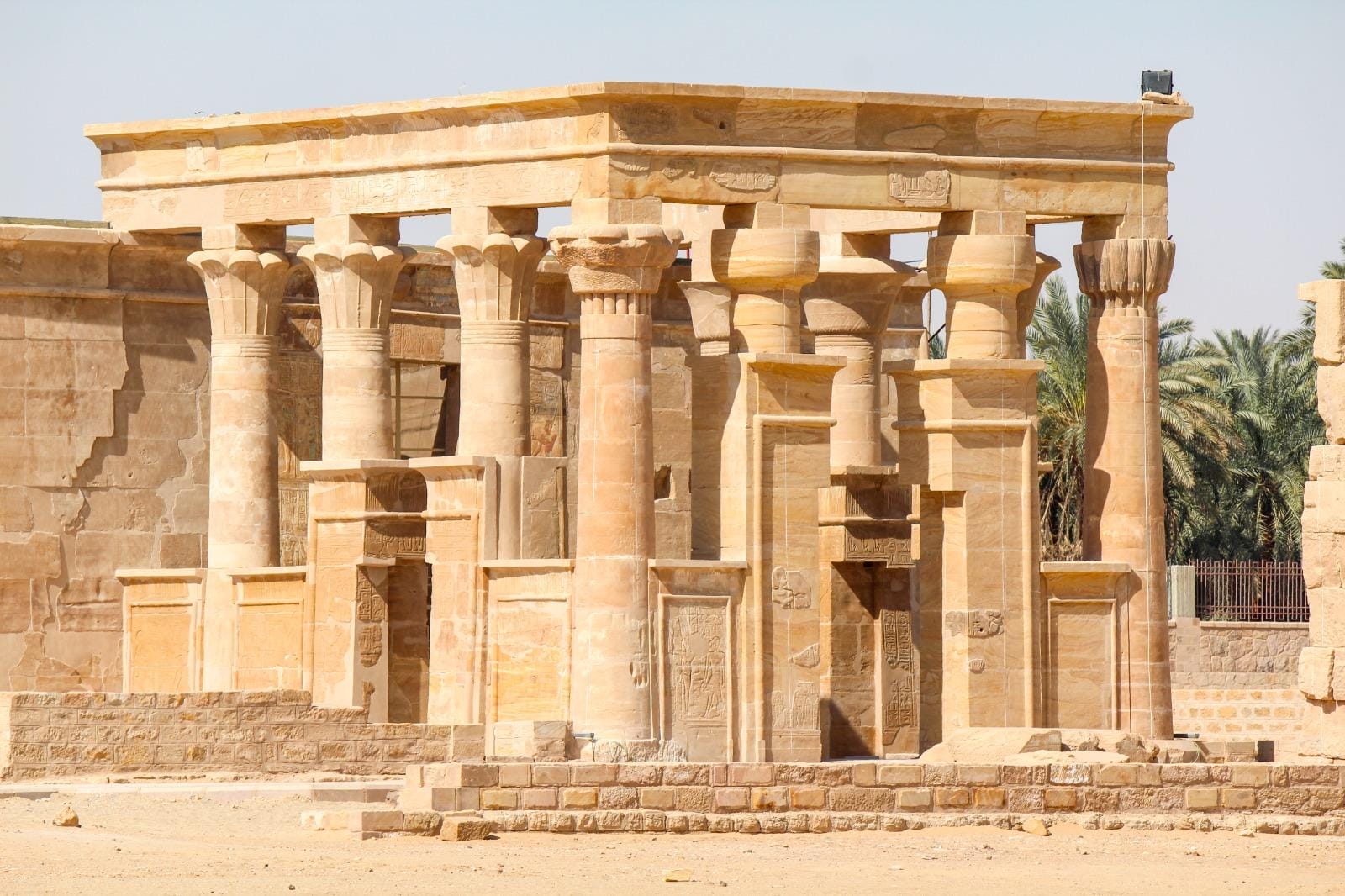More than 10 Must-See Sites in Kharga Oasis
Kharga Oasis, located in the heart of Egypt’s Western Desert, is an intriguing blend of natural beauty and ancient history. As the largest and one of the most accessible oases in Egypt, it offers visitors a variety of historical sites, archaeological wonders, and unique desert landscapes. Here’s a list of the key sites you can explore when visiting Kharga Oasis:
The Temple of Hibis
The Temple of Hibis is one of the most prominent historical sites in Kharga Oasis. It dates back to the 26th Dynasty (around the 6th century BC) and is dedicated to the gods Amun, Mut, and Khonsu. The temple is a wonderful example of ancient Egyptian religious architecture, with impressive reliefs and inscriptions that depict pharaohs, gods, and ancient rituals. It is remarkably well-preserved and offers a glimpse into the religious practices during Egypt’s later periods, particularly during the Persian occupation.
Kharga Oasis Museum
The Kharga Oasis Museum provides an excellent introduction to the history and culture of the oasis. It houses a rich collection of artifacts, including pottery, statues, tools, and textiles from the Pharaonic, Roman, and Islamic periods. The museum also highlights the region’s unique agricultural heritage and how the oasis has evolved. It is a must-visit for those looking to learn about the local history and the role Kharga has played throughout Egyptian civilization.
The Roman Tombs at Qasr al-Zayan
The Roman Tombs of Qasr al-Zayan are a set of ancient tombs carved into the desert cliffs. These tombs date back to the 1st and 2nd centuries AD, during the Roman occupation of Egypt. The tombs are decorated with detailed frescoes and inscriptions that provide a fascinating look at the burial practices and religious beliefs of the Roman settlers in the oasis. The site is a peaceful place, offering a glimpse into the daily lives of those who lived here during Roman times.
The Oasis of El-Dakhla
While Kharga is the largest oasis in the Western Desert, it is also closely linked with nearby El-Dakhla Oasis. A visit to Dakhla offers additional historical sites, such as the Temple of Deir El-Hagar and the medieval village of Al-Qasr. Exploring both oases gives visitors a deeper understanding of the cultural and archaeological richness of the region.
The Well of the Forty (Bir al-Hadid)
The Well of the Forty, also known as Bir al-Hadid, is a historic well located near Kharga. According to local legend, the well is named after forty soldiers who died guarding it, and their spirits are said to haunt the area. It is a vital water source for the oasis and continues to serve local inhabitants. The well is surrounded by beautiful desert scenery, making it a tranquil spot to visit and reflect on the oasis’ role in survival in the harsh desert environment.
The Islamic Fortress of Qasr al-Dab’a
Qasr al-Dab’a is an ancient Islamic fortress that dates back to the 7th century AD, built during the early Islamic period. The fortress was constructed to protect the oasis and safeguard trade routes through the desert. Today, it stands as a fascinating historical monument showcasing early Islamic architecture and military strategy. Visitors can explore the ruins of the fortress, which includes walls, towers, and a mosque while enjoying views of the surrounding desert.
The Desert and Sand Dunes
Kharga Oasis is surrounded by vast desert landscapes that are perfect for desert safaris. The dunes and rocky hills create a stunning contrast with the green oasis. Taking a 4×4 jeep or camel ride through the desert allows visitors to explore the unique terrain, including salt flats, dunes, and remote sites. It’s an excellent opportunity for stargazing under the clear desert skies, far from the lights of urban areas.
The Natural Springs
Kharga is home to several natural hot and cold springs that have been used for centuries by local people for their therapeutic qualities. Springs such as Ain al-Gazzara and Ain Umm el-Dabadib are popular destinations for relaxation, with their warm mineral waters believed to have healing properties. These springs are nestled in the desert landscape and provide a peaceful respite, perfect for unwinding after a day of exploring the archaeological sites.
The Christian Caves
In the region surrounding Kharga, you can visit ancient Christian caves, which were used as both homes and places of worship by early Christian settlers. The caves are carved into the rock and are some of the oldest Christian sites in Egypt. Many of these caves still feature remnants of religious frescoes, inscriptions, and artifacts that showcase the early Christian presence in the region. They offer a unique glimpse into how people adapted to life in the desert.
Bedouin Villages
Visiting the traditional Bedouin villages in and around Kharga Oasis provides a chance to experience the local way of life. The Bedouins, who have long inhabited the desert, maintain a lifestyle closely tied to the rhythms of the oasis. You can learn about their customs, culture, and survival techniques in the desert. The villagers often welcome visitors with warm hospitality, and you can purchase locally made handicrafts, such as textiles, pottery, and jewelry.
The Date Palm Groves
The oasis is famous for its extensive date palm groves, which are essential to the region’s agricultural economy. Kharga’s date palms thrive in the fertile soil provided by the underground water sources. Visitors can take a tour of these groves, learn about date cultivation and even taste the variety of dates grown here. Dates from Kharga are renowned for their sweetness and quality, and they are often sold in markets throughout Egypt.
Conclusion
Kharga Oasis is a fascinating destination offering a blend of ancient history, natural beauty, and cultural experiences. Whether you’re exploring the ancient Temple of Hibis, marveling at the Roman tombs of Qasr al-Zayan, or taking in the tranquil desert landscapes on a safari, Kharga Oasis provides a unique glimpse into Egypt’s rich history and desert life. With its welcoming atmosphere, rich archaeological sites, and stunning natural scenery, Kharga Oasis is a hidden gem waiting to be explored.

